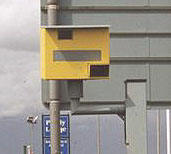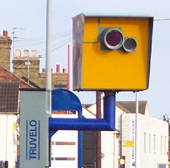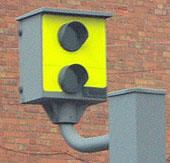I've seen many people ask about the type of
speed cameras over the last few weeks and how they know if they got caught or not. So i'll explain.
Cameras Types
Gatso Speed Camera

here are over 4,000 fixed Gatso
speed cameras currently in use by police forces and local authorities across the UK, accounting for 90% of all fixed
speed cameras. The Gatso which uses radar technology, is used for fixed
speed cameras, in-car mobile units, on tripods and can even be used from moving vehicles.
Fixed Gatso
speed cameras are rear facing. This is so the cameras 'flash' does not blind oncoming motorists. Unfortunately, this also means the cameras are not always viewable until the last second (as pictured above). The cost of installing a Gatso
speed camera is approximately £20,000, but can cost as much as £40,000 if located in a rural location, as the system requires a 240v power supply.
The fixed Gatso
camera has the ability to take up to 400 pictures. Cameras in that are located in busy areas or are particularly hidden, often only last a few hours before the film runs out, soon recouping the £20,000-£40,000 price tag.
Gatso
speed cameras can also identify between cars/vans and HGVs separately. For example, if the
speed limit was 60mph for cars/vans and 40mph for HGVs the
camera will enforce the two separate limits.
It is common for fixed Gatsos to be positioned so they can be turned around to check both sides of the road - but only one direction at a time.
On the M25 in Berkshire and Surrey Gatso
speed cameras have been placed in gantries across the width of the motorway with all four lanes covered simultaneously.
Points and Penalties
Being prosecuted in the UK by a Gatso
speed camera can result in a minimum of 3 penalty points and a £60 fine. Fine amounts are currently under review by the government and may increase in near future.
--------------------------------------------------------------------------
Truvelo Speed Cameras

The forward facing Truvelo
camera system is designed to take photographs of the front of a passing vehicle, this allows the picture taken to show the driver of the vehicle as well.
To avoid the 'flash' which is given out by a rear facing Gatso
camera the Truvelo system uses an infra red flash which produces no visible 'flash' to the approaching driver. These rely on 3 white-lines in the road, painted just before the
camera, and are triggered by strips in the road, used to gain the vehicles
speed.
Truvelo cameras are becoming increasingly more commonplace, counties such as Northamptonshire use predominately only Truvelo cameras.
Points and Penalties
Being prosecuted in the UK by a Truvelo speed/safety
camera can result in a minimum of 3 penalty points and a £60 fine. This fine amount is currently under review by the government and may increase in near future.
--------------------------------------------------------------------------
SPECS Speed Cameras



SPECS average
speed camera systems utilise state of the art video system with Automatic Number Plate Reading (ANPR) digital technology. Consisting of a minimum of two cameras each fitted with infra red illuminators fitted on gantries above the road, so they can work day or night. SPECS
speed cameras work out the vehicles average
speed, given the time it takes to drive between the two
camera positions.
SPECS average
speed cameras are fitted either at the roadside or in the central reservation (as pictured below) a set distance apart to create a
speed controlled zone, or where appropriate, groups of cameras can be linked to create a
speed controlled network.
As vehicles pass between the entry and exit
camera points their number plates are digitally recorded, whether speeding or not. Then, by ANPR recognition, the images on the video of matching number plates are paired up, and because each image carries a date and time stamp, the computer can then work out your average
speed between the cameras. There is no film used for SPECS.
SPECS are commonly used to enforce
speed limits on dual carriageways and motorways. This is because one SPECS gantry can monitor up to four lanes of traffic at any one time.
Nottinghamshire currently has the most SPECS
speed cameras with no less than 43 pairs all located in permanent sites.
SPECS
speed camera are currently in use in permanent locations in the following counties: Northamptonshire, Nottinghamshire, Greater London, Northern Ireland, Strathclyde, Cornwall, Gloucestershire and South Yorkshire.
In addition SPECS average
speed cameras are being used in the following temporary locations: Hertfordshire, Kent, Wiltshire/Berkshire, Devon, Perthshire, Cheshire, Greater Manchester, Staffordshire and West Midlands.
Quote from the manufactures of SPECS system. "The SPECS system is so efficient and user friendly that Manchester CTO processed 2,500 offences in 6 man-hours".
Points and Penalties
Being prosecuted in the UK by a SPECS speed/safety
camera system can result in a minimum of 3 penalty points and a £60 fine. This fine amount is currently under review by the government and may increase in near future.
--------------------------------------------------------------------------
Peek Speed Cameras

PEEK Traffic cameras within the United Kingdom are in minority in built up areas. Counties currently using Peek Traffic cameras include; Leicestershire, Greater London and Berkshire.
Peek rely on radar technology, similar to a Gatso. They are also rear-facing due to the 'flash'.
Points and Penalties
Being prosecuted in the UK by a Peek speed/safety
camera can result in a minimum of 3 penalty points and a £60 fine. This fine amount is currently under review by the government and may increase in near future.
--------------------------------------------------------------------------
Speedcurb Speed Cameras

Speedcurb roadside
speed cameras are often used to monitor traffic light offences as well as speeding offences. These traffic cameras are rear facing and are used in fixed permanent
speed camera locations. Like both DS2 and Truvelo
speed cameras, SpeedCurb use piezo sensors embedded in the road.
Speedcurb
speed camera use piezo sensors in the road surface to calculate the
speed of a vehicle passing through the cameras enforcement zone.
Points and Penalties
Being prosecuted in the UK by a Speedcurb
speed camera can result in a minimum of 3 penalty points and a £60 fine. Fine amounts are currently under review by the government and may increase in near future.
--------------------------------------------------------------------------
Watchman Speed Cameras

Watchman
speed cameras are rear facing roadside cameras similar to Gatso
speed cameras using radar to detect speeding vehicles. Watchman traffic cameras are currently on trial awaiting type approval prior to a national installation programme. In addition to the radar module, Watchman also features a second
camera for Number Plate Recognition (NPR).
Watchman
speed cameras work using radar technology like a Gatso. A radar stream is constantly emitted and when a vehicle passes through above the
speed limit a photograph is taken. But unlike a Gatso the Watchman traffic
camera calculates your
speed as you approach the
camera location. Slowing down just as you reach the Watchman
speed camera isn't enough as your
speed will have already been monitored and will be recorded as you pass the
camera, together with a photo of your vehicle. This provides the Watchman
speed camera system with a much larger area of monitoring and enforcing the road
speed limit.
Points and Penalties
Being prosecuted in the UK by a Watchman
speed camera can result in a minimum of 3 penalty points and a £60 fine. Fine amounts are currently under review by the government and may increase in near future.



